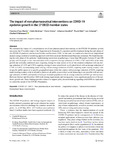The impact of non-pharmaceutical interventions on COVID-19 epidemic growth in the 37 OECD member states
Pozo-Martin, Francisco
Weishaar, Heide
Cristea, Florin
Hanefeld, Johanna
Bahr, Thurid
Schaade, Lars
El Bcheraoui, Charbel
We estimated the impact of a comprehensive set of non-pharmeceutical interventions on the COVID-19 epidemic growth rate across the 37 member states of the Organisation for Economic Co-operation and Development during the early phase of the COVID-19 pandemic and between October and December 2020. For this task, we conducted a data-driven, longitudinal analysis using a multilevel modelling approach with both maximum likelihood and Bayesian estimation. We found that during the early phase of the epidemic: implementing restrictions on gatherings of more than 100 people, between 11 and 100 people, and 10 people or less was associated with a respective average reduction of 2.58%, 2.78% and 2.81% in the daily growth rate in weekly confirmed cases; requiring closing for some sectors or for all but essential workplaces with an average reduction of 1.51% and 1.78%; requiring closing of some school levels or all school levels with an average reduction of 1.12% or 1.65%; recommending mask wearing with an average reduction of 0.45%, requiring mask wearing country-wide in specific public spaces or in specific geographical areas within the country with an average reduction of 0.44%, requiring mask-wearing country-wide in all public places or all public places where social distancing is not possible with an average reduction of 0.96%; and number of tests per thousand population with an average reduction of 0.02% per unit increase. Between October and December 2020 work closing requirements and testing policy were significant predictors of the epidemic growth rate. These findings provide evidence to support policy decision-making regarding which NPIs to implement to control the spread of the COVID-19 pandemic.
Dateien zu dieser Publikation

